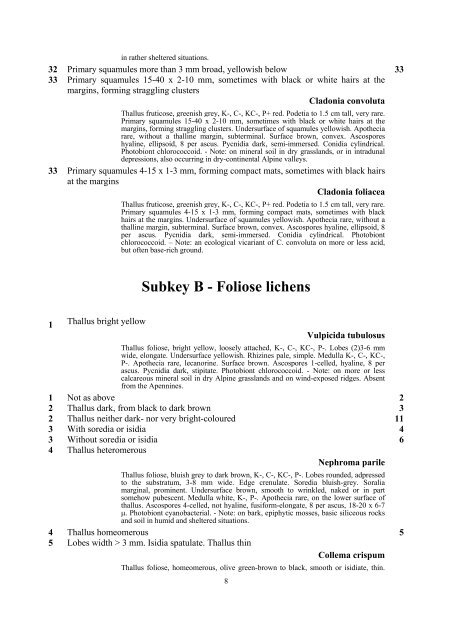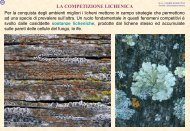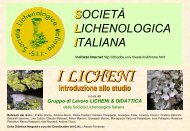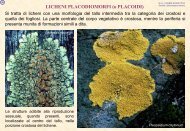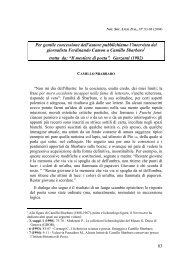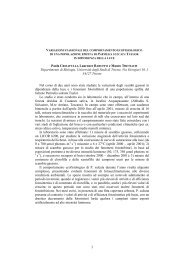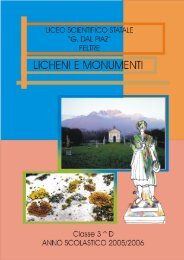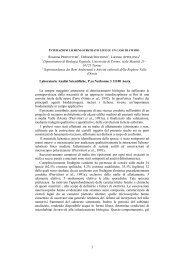KEY to terricolous lichens - italic
KEY to terricolous lichens - italic
KEY to terricolous lichens - italic
You also want an ePaper? Increase the reach of your titles
YUMPU automatically turns print PDFs into web optimized ePapers that Google loves.
32<br />
in rather sheltered situations.<br />
Primary squamules more than 3 mm broad, yellowish below 33<br />
33 Primary squamules 15-40 x 2-10 mm, sometimes with black or white hairs at the<br />
margins, forming straggling clusters<br />
Cladonia convoluta<br />
Thallus fruticose, greenish grey, K-, C-, KC-, P+ red. Podetia <strong>to</strong> 1.5 cm tall, very rare.<br />
Primary squamules 15-40 x 2-10 mm, sometimes with black or white hairs at the<br />
margins, forming straggling clusters. Undersurface of squamules yellowish. Apothecia<br />
rare, without a thalline margin, subterminal. Surface brown, convex. Ascospores<br />
hyaline, ellipsoid, 8 per ascus. Pycnidia dark, semi-immersed. Conidia cylindrical.<br />
Pho<strong>to</strong>biont chlorococcoid. - Note: on mineral soil in dry grasslands, or in intradunal<br />
depressions, also occurring in dry-continental Alpine valleys.<br />
33 Primary squamules 4-15 x 1-3 mm, forming compact mats, sometimes with black hairs<br />
at the margins<br />
Cladonia foliacea<br />
Thallus fruticose, greenish grey, K-, C-, KC-, P+ red. Podetia <strong>to</strong> 1.5 cm tall, very rare.<br />
Primary squamules 4-15 x 1-3 mm, forming compact mats, sometimes with black<br />
hairs at the margins. Undersurface of squamules yellowish. Apothecia rare, without a<br />
thalline margin, subterminal. Surface brown, convex. Ascospores hyaline, ellipsoid, 8<br />
per ascus. Pycnidia dark, semi-immersed. Conidia cylindrical. Pho<strong>to</strong>biont<br />
chlorococcoid. – Note: an ecological vicariant of C. convoluta on more or less acid,<br />
but often base-rich ground.<br />
Subkey B - Foliose <strong>lichens</strong><br />
1 Thallus bright yellow<br />
Vulpicida tubulosus<br />
Thallus foliose, bright yellow, loosely attached, K-, C-, KC-, P-. Lobes (2)3-6 mm<br />
wide, elongate. Undersurface yellowish. Rhizines pale, simple. Medulla K-, C-, KC-,<br />
P-. Apothecia rare, lecanorine. Surface brown. Ascospores 1-celled, hyaline, 8 per<br />
ascus. Pycnidia dark, stipitate. Pho<strong>to</strong>biont chlorococcoid. - Note: on more or less<br />
calcareous mineral soil in dry Alpine grasslands and on wind-exposed ridges. Absent<br />
from the Apennines.<br />
1 Not as above 2<br />
2 Thallus dark, from black <strong>to</strong> dark brown 3<br />
2 Thallus neither dark- nor very bright-coloured 11<br />
3 With soredia or isidia 4<br />
3 Without soredia or isidia 6<br />
4 Thallus heteromerous<br />
4<br />
Nephroma parile<br />
Thallus foliose, bluish grey <strong>to</strong> dark brown, K-, C-, KC-, P-. Lobes rounded, adpressed<br />
<strong>to</strong> the substratum, 3-8 mm wide. Edge crenulate. Soredia bluish-grey. Soralia<br />
marginal, prominent. Undersurface brown, smooth <strong>to</strong> wrinkled, naked or in part<br />
somehow pubescent. Medulla white, K-, P-. Apothecia rare, on the lower surface of<br />
thallus. Ascospores 4-celled, not hyaline, fusiform-elongate, 8 per ascus, 18-20 x 6-7<br />
µ. Pho<strong>to</strong>biont cyanobacterial. - Note: on bark, epiphytic mosses, basic siliceous rocks<br />
and soil in humid and sheltered situations.<br />
Thallus homeomerous 5<br />
5 Lobes width > 3 mm. Isidia spatulate. Thallus thin<br />
Collema crispum<br />
Thallus foliose, homeomerous, olive green-brown <strong>to</strong> black, smooth or isidiate, thin.<br />
8


